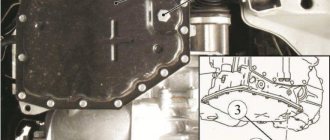Changing the oil in the Kia Rio gearbox is one of the most important points in car maintenance and, in particular, in the transmission. It's no secret that oils lose their cooling and lubricating properties over time, so for the correct operation of your car it is extremely important that the lubricant poured into the gearbox is in acceptable condition.
This is especially important for Korean-made cars, because they are most often used in the harsh conditions of Russian roads.
One of the most popular models of the Korean automobile industry at the moment is the Kia Rio (as of 2016, it is the best-selling car in Russia). This article will discuss changing the oil in a Kia Rio manual transmission.
Technical recommendations (Regulations for changing gearbox oil from Kia Rio)
So, although the Kia Rio gearbox has become more reliable, as in any other unit, it is recommended to change the lubricant periodically. Otherwise, the service life of the gearbox may be significantly reduced, and there may also be problems with the mileage during operation (noise, howling of the gearbox, problems with gear shifting, etc.);
At the same time, the manufacturer determines the regulations for changing the oil in the gearbox that the oil needs to be changed only if it is necessary to repair the gearbox when disassembling it, and also if the mileage has exceeded 200 thousand km. In other words, the oil is filled for the entire service life of the car.
You should also take into account the operating characteristics of the vehicle, the load on the transmission, the quality of the transmission oil itself, and possible minor leaks through oil seals, gaskets and seals. It is quite obvious that increased attention should be paid to the issue of the condition and level of oil in the gearbox. In simple words, the lubricant needs to be refreshed and changed.
As for the replacement itself, for these purposes you need to unscrew the drain plug, also unscrew the oil level control hole plug, drain the waste and pour fresh oil into the gearbox. Filling can be done through the reverse switch.
Taking into account the fact that the manual does not indicate which oil to pour into a Rio gearbox with a mechanical drive, you can select the products listed below. You should also study the recommendations in the manuals for other Kia models, which allows you to expand the list of oils, that is, use analogues.
For example, G-BOX Expert 80W85 or 75W90 oil is suitable; Gazpromneft 80W90 or 80W85, TNK TRANS KP 80W85 or TNK TRANS KP SUPER 75W90, LUKOIL TM-4 75W85, 75W80, 80W85, 75W90 or 80W90, Rosneft KINETIC 80W85, SHELL SPIRAX S5 ATE or TRANSAXLE OIL 75W90, etc. You can also select other analogues (Liqui Moly, ZIC, etc.).
The main thing is that the product meets class GL-4 or GL-4/GL-5, but not GL-5, as well as all tolerances and standards recommended by the manufacturer. The fact is that GL-5 oils, on the one hand, are considered a more modern option, but they are more designed to protect gears and loaded surfaces. At the same time, the gearbox synchronizers, which are made of soft alloys, wear out greatly.
Also, when choosing oil for a Kia Rio manual transmission, you need to take into account the temperature range within which a particular vehicle is operated. Briefly, if in winter the temperature does not drop below -12 and does not rise above +50 Celsius, then 85W90 oil is suitable.
A drop in temperature to -26 indicates the need to fill the box with 80W90. If the temperature rises above +35 in summer and drops to -40 in winter, then it is optimal to use 75W80 or 75W85 oils. In cases where the temperature rises to +45 in summer and drops to -40 in winter, then gear oil with a viscosity index of 75W90 is suitable.
When is it necessary to change the oil?
The replacement period for a manual transmission is not determined by the technical documentation for the car. The manufacturer installs the technical service by default. fluids for the entire period of operation of the machine. But in practice this usually does not happen.
The degree of wear of roads and the mode of driving a vehicle often leads to the need to add or change oil, completely filling in new oil. Professional auto mechanics recommend changing the lubricant in a manual transmission at least once every 90 thousand kilometers.
It is recommended to check its condition once every 10-15 thousand kilometers. For automatic transmissions, the manual sets the replacement period at 100 thousand km, but it is also usually less.
When choosing a technical fluid, it is better to choose a synthetic lubricant of the SAE 75W/85 or 75/90 standard according to API GL-4. As for manufacturers, it is recommended to choose products from the Korean automaker Hyundai; its products are most suitable for Kia.
Which oil is best to fill according to the regulations?
The choice of the optimal oil option for the Kia Rio 3, including the previous generation Kia Rio 2, should be approached with special care. The market space today is overflowing with offers of this product, which has different viscosity and temperature properties.
We should not forget about the rather high risk of encountering a fake. It is better to work hard and look for original products, which will reduce the risk of incorrect operation of the transmission or its possible failure.
If the owner managed to find a product that is suitable in terms of quality, then the next time it is replaced, there is no point in resorting to another manufacturer or brand.
Specific names
Let's highlight well-known brands and the main parameters of oils that are best suited for Kia Rio manual transmission:
Mobil 1 SHC
- Oil type – all-season, synthetic
- SAE class parameters – 75W/90
- Parameters by API class – GL4
Lukoil TM-5
- Oil type – semi-synthetic
- SAE class - 75W/90
- API Class – GL-5
Castrol Suntrans Transacl
- Oil type - synthetic
- SAE class – 75W90
- API class – GL4
Toyota
- Type – synthetic
- SAE class – 75W/90
- API class – GL4/GL5
Mobil GX
- Oil type - synthetic
- SAE Class – 80W
- API Class – GL-5
Lukoil TM-5
- Oil type - synthetic
- SAE class – 85W/90
- API class – GL5
Step-by-step instructions for changing the oil in a Kia Rio manual transmission
In order to change the oil in a Kia Rio manual transmission, we perform the following steps:
- The very first thing you need to do is warm up the gearbox. We start the car and drive a few kilometers so that the used oil warms up. This is done because heated oil has a more liquid structure and drains better.
- Now we cut out a piece of plastic in the previously prepared container so that the used oil flows there
- We use a jack and lift the right side of the car.
- We crawl under the car and find the drain hole. If there is a crankcase protection, then, as a rule, a special technological hole is made in it for changing the oil. If the protection is solid, then it will have to be removed. When the hole is found, use a metal brush to clean it from dirt and dust. After cleaning, wipe the plug and the area around it with a clean rag.
- We use the key “17” to unscrew the drain plug. We first install the prepared container under it. When the used oil runs, be careful because it is warm and can burn your hands, so work only with gloves and long sleeves. We wait about 15 minutes for the old oil to completely drain out.
- While the “working off” is draining, you need to free access to the car’s filler plug. To do this, disconnect the battery terminal. After this, unscrew the mounting screws of the air filter housing. We also disconnect the mass air flow sensor terminal and all other wires (hoses) that may interfere when removing the housing.
- Now you can move the air filter housing to the side.
- Find the oil level dipstick on the gearbox and remove it.
- We tighten the drain plug from the bottom of the car. During this time, the mining should have drained completely.
- Cut out a funnel from a plastic container that will serve as a filler. We place it above the filler hole from which the dipstick was pulled out. Some people use an additional hose between the hole and the funnel if there is no other way to place the cut part of the bottle.
- We fill in new oil and check that there is no leakage through the drain hole. It may appear after a few minutes due to the plug being loose. We select the volume of oil that needs to be filled based on the type of gearbox. Make the first fill a little less than normal, so that later you can add oil if necessary.
- After filling in new oil, check its level with a dipstick. If topping up is needed, we do it according to the method we have studied, but only after removing the car from the jack. The level should not be higher than the MAX mark. If it turns out that you filled in a lot of oil, it needs to be drained through the control hole.
- We wipe off the places where drops of oil remain on the box, and then install the air filter housing in the reverse order.
Types of oils
- Synthetic is the most modern oil today. Has a record degree of fluidity. This is the rarest oil that cannot freeze at extremely low temperatures. Thanks to this, synthetics are especially in demand not only in the summer season, but also in harsh winter conditions
- Mineral is the complete opposite of synthetic. This is the thickest oil that hardens quickly at low temperatures. Because of this, there may be problems with shifting gears and even starting the engine. Therefore, this lubricant is not recommended for winter conditions. Mineral oil makes sense only with very high mileage. Mineralka is in high demand among owners of old cars
- Semi-synthetic is a kind of variety between synthetics and mineral water. This oil contains approximately the same amount of the two types, but there is still a little more mineral lubricant. Semi-synthetics are also not recommended for extremely low temperatures. And yet, in terms of quality and stability, semi-synthetics are several times better than mineral oil.
Based on the above, we can conclude that the best option for the Kia Rio gearbox would be synthetic oil.
How to choose a lubricant for Kia Rio automatic transmission models 1 to 4
In order for the oil in the Kia Rio automatic transmission to perform its functions, you must buy only branded lubricants. You should know that each product has specifications and properties unique to it.
For example, ATF SP III is suitable for a Kia Rio automatic transmission. The manufacturer of the material is Diamond. It has analogues that are also suitable for operating an automatic transmission. About analogues in the block below.
For different modifications of Kia vehicles, you need to select the required volume.
- for a Kia Rio with a JB modification interior (or the second generation of the car brand) you will need 6.1 liters of lubricant;
- The automatic transmission in the Kia Rio UB modification requires 6.2 liters;
- for an automatic in the back of the DC model (first generation) you will need 6.8 liters.
Lubricant from the manufacturer
The real oil in the automatic transmission from the factory is ATF SP 3. What distinguishes it from its analogues is its high viscosity coefficient and the optimal amount of additives. Protects clutches from wear. This oil has antioxidant properties.
Distinctive features of the characteristics of the original oil from analogues of the Hyundai ATF SP III type are given in the table:
| ATF SP III from Diamond | Hyundai ATF SP III | Chevron ATF SP III | |
| Viscosity at operating temperature | 35 | 35 | 35 |
| Pour point | – 40 | – 40 | – 40 |
| Amount of alkali | 3,7 | 3,7 | 3,7 |
| Color | Red | Red | Red |
As can be seen from the table, the analogues are identical in their properties to the oil from the manufacturer.
Read
Changing transmission oil in a Kia Cerato automatic transmission yourself
Similar brands of oil
Analogues of the original oil in a Kia box include the following types:
- Hyundai ATF SP III;
- ZIC ATF SP III;
- Aisin ATF AFW+.
Attention! Once a season, the car owner is obliged to find out how much oil is in the Kia Rio automatic transmission and top it up as needed.











